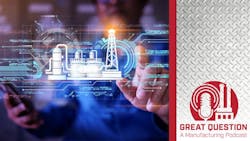Podcast: How connected worker technologies are reshaping the future of manufacturing
Jerry Grunewald is vice president of operations innovation at INVISTA and has occupied leadership positions in R&D and operations during his 35-year career. Additionally, Jerry managed INVISTA’s digital transformation efforts, working to make the plant of the future a reality. Eric Whitley is director of industrial transformation at L2L. With over 25 years of manufacturing and business improvement experience, Eric works to help manufacturers bridge the gap between digital technology and the factory floor. Jerry and Eric recently spoke with Dennis Scimeca, senior editor for technology at IndustryWeek, about connecting frontline workers with back-end manufacturing technology.
Below is an excerpt from the podcast:
IW: How would you summarize, in the most general terms, what the goal of the connected worker initiative ought to be? What do all the different technology options have in common in terms of what they're meant to accomplish?
EW: I can start off with basically what we say here at L2L, and that is our goal is to help frontline workers manufacture better together. So, a connected worker platform is there to be the front-facing piece of software that the frontline worker is using to see all of the data and all of the information that the systems, processes, upper pieces of software (like ERPs and MESs, and all that) and lower pieces of software (like SCADA systems and all of that) are bringing all this data together and putting it on a single pane of glass so that the operator can see it and make decisions about what they need to do out on the shop floor.
JG: I think that's a really good summary, Eric. I like that. Our tagline is, kind of, you want to bring the right information at the right time to the right person, and most importantly, in the right context, which is often the hardest thing to do. Just as you say, you bring all that together and hopefully enable them to make a decision, take an action that they couldn't have done before without this kind of synthesis of information. Hopefully the work and the worker is transformed because of the way this is all pulled together now.
IW: What does connected worker technology mean precisely when we talk about hardware? What are the hardware options for connected worker systems?
EW: What we're seeing mostly getting used is mobile devices, kiosks out on the shop floor, and phones. Most of leadership uses their phones to do that connection. The workers on the shop floor are still using iPads, kiosks, and stuff like that. Now, the external part of that, or the sub hardware that you are seeing people beginning to use, are things like glasses and VR devices, and stuff like that. But that really hasn't grabbed hold yet. I don't think the technology is quite there, but that's kind of what we're seeing from a hardware standpoint. From a platform standpoint, connected worker software, ours is a SaaS solution so nobody is having to do servers or on-prem type of work. We do all that work in the background.
JG: Our mental model from the get go was to try to be hardware agnostic because that space is changing so fast. So, you don't want to necessarily invest heavily in a certain type of glass or headset monitor or something like that. Really focus on the platform, as you say. First thing is get all of your plants, which we did a number of years ago, industrially Wi-Fi ready, get your platform set, get your data so it can be contextualized because the hardware stuff will keep changing, keep integrating. But if you're ready on a platform and your workforce is ready to use these tools, that's really where we encourage folks to spend their time. You know, most of your time and certainly initially almost all of your time.
EW: I said that the connected worker space is really the outcome of three pieces of hardware coming to fruition in the last 15 years. It's not been that long since every plant now has Wi-Fi in it. That had to happen. And then the mobile device had to be prevalent and then the cloud had to be usable, secure, sustainable and reliable. With those three things coming together, that really led to the connected worker space and the connected worker platforms really being able to kind of take off and be more user friendly.
Learn about manufacturing technologis
Operators Connected by Technology Don’t Quit
At a time when workforce shortages plague manufacturing, consider that a connected worker might not walk out the door and leave you hanging.
Never Mind Metrics: You Can't Always Measure Transformation
When Koch Industries demanded change, subsidiary Invista collaborated with Amazon Web Services to create a digital twin system that could pay dividends for decades.
About the Podcast
Great Question: A Manufacturing Podcast offers news and information for the people who make, store and move things and those who manage and maintain the facilities where that work gets done. Manufacturers from chemical producers to automakers to machine shops can listen for critical insights into the technologies, economic conditions and best practices that can influence how to best run facilities to reach operational excellence.
Listen to another episode and subscribe on your favorite podcast app
About the Author
Dennis Scimeca
Dennis Scimeca is a veteran technology journalist with particular experience in vision system technology, machine learning/artificial intelligence, and augmented/mixed/virtual reality (XR), with bylines in consumer, developer, and B2B outlets. At IndustryWeek, he covers the competitive advantages gained by manufacturers that deploy proven technologies. If you would like to share your story with IndustryWeek, please contact Dennis at [email protected].
